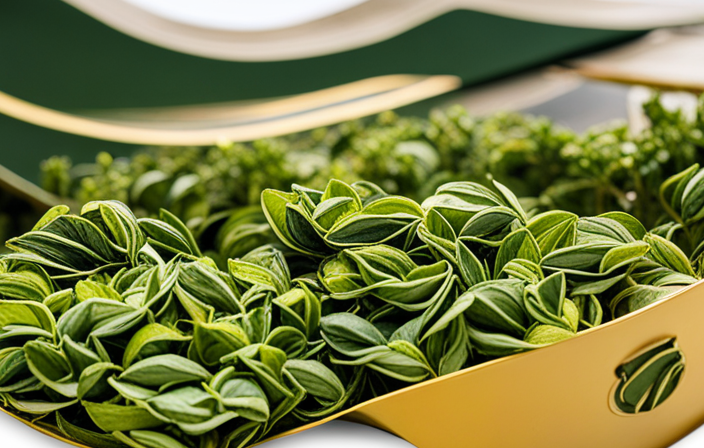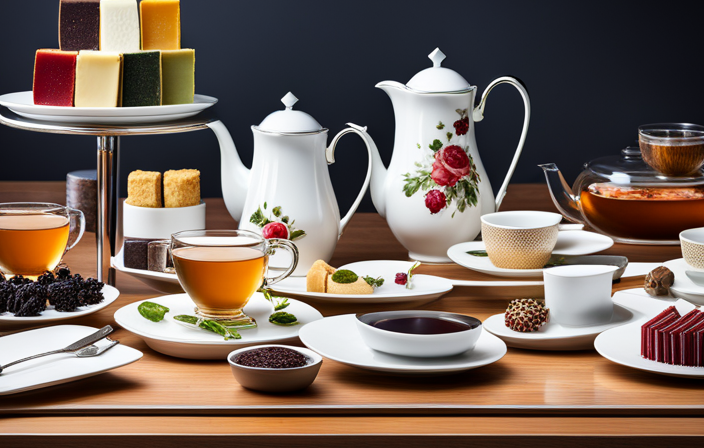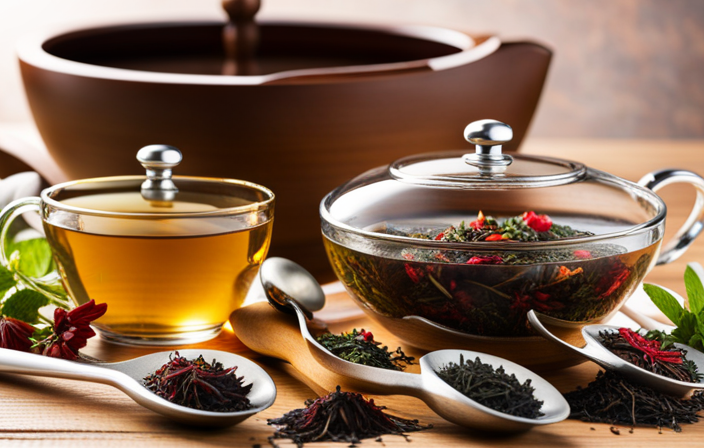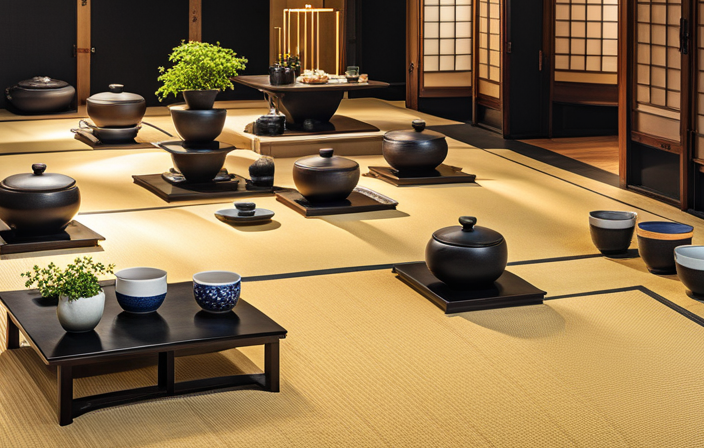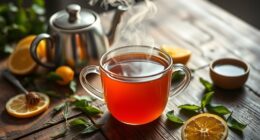As a tea lover, I’ve always wondered about the process behind creating the perfect cup. And let me tell you, it’s a fascinating journey from leaf to brew.
From the moment the tea leaves are harvested to the final packaging and storage, each step plays a crucial role in ensuring the quality and flavor we all enjoy.
So, if you’re curious about the essential steps involved in the production of tea, buckle up and join me on this informative and enlightening adventure.
Key Takeaways
- Harvesting techniques play a crucial role in ensuring the quality of tea leaves, considering factors such as weather conditions, plant maturity, and leaf quality.
- The production process involves withering and rolling, which are essential steps in shaping and enhancing the flavor and aroma of the tea leaves.
- Oxidation is a significant step that brings out desired flavors and aromas in tea leaves, and controlled oxidation is crucial in determining the final characteristics of the tea.
- Drying, sorting, and quality control are essential in preserving the flavor and quality of tea leaves, including using various drying methods, sorting based on size and quality, and maintaining consistency through quality control measures.
Harvesting
I have harvested a few tea leaves from my backyard garden for brewing a fresh cup of tea. Harvesting techniques play a crucial role in the production of tea, ensuring that the leaves are picked at the right time to achieve optimal flavor.
In tea plantation management, it’s important to consider factors such as weather conditions, plant maturity, and leaf quality. The two main harvesting techniques are hand plucking and machine harvesting.
Hand plucking involves carefully selecting and plucking the top two leaves and a bud, which are considered the highest quality. Machine harvesting, on the other hand, uses mechanical devices to strip the leaves from the plants. This method is usually employed for mass production.
Regardless of the technique used, proper harvesting is essential to maintain the integrity and flavor of the tea leaves.
Withering
Sometimes, the tea leaves are withered indoors for a specific period, and other times they are withered outdoors to allow for natural air circulation. The withering process is a crucial step in tea production as it helps to remove excess moisture from the leaves, making them pliable for the next stage of rolling. The withering techniques and duration can vary depending on the type of tea being produced. For example, green teas are typically withered for a shorter duration compared to black teas. To give you a better understanding, here is a table showcasing the withering techniques and duration for different types of teas:
| Tea Type | Withering Technique | Withering Duration |
|---|---|---|
| Green Tea | Indoor | 1-2 hours |
| Black Tea | Outdoor | 10-12 hours |
| Oolong Tea | Indoor/Outdoor | 4-6 hours |
| White Tea | Indoor/Outdoor | 12-24 hours |
Now that we understand the withering process, let’s move on to the next step: rolling.
Rolling
Rolling is an essential step in the production of tea, where the leaves are gently rolled to shape and release their natural juices. This technique helps to break down the cell walls, allowing the tea leaves to oxidize and develop their unique flavors and aromas.
The benefits of rolling include enhancing the infusion process and improving the overall quality of the tea.
Rolling Technique Explained
There are several important steps involved in the rolling technique that contribute to the flavor and aroma of the tea. To achieve the desired result, the rolling process must be carried out meticulously. Here are the essential steps:
-
Withering: The first step involves withering the freshly plucked tea leaves to reduce moisture content and make them pliable for rolling.
-
Rolling: This step involves gently rolling the withered leaves to break their cell walls, releasing essential oils and enzymes that enhance the flavor and aroma of the tea.
-
Oxidation: After rolling, the leaves are left to oxidize. This step allows the tea to develop its unique characteristics and flavors.
-
Drying: Finally, the leaves are dried to halt the oxidation process and lock in the desired flavors and aromas.
The rolling technique benefits the tea by enhancing the release of essential oils, enzymes, and flavor compounds. This process impact ensures that the tea leaves are properly conditioned, resulting in a more balanced and enjoyable cup of tea.
Benefits of Rolling
I can definitely taste the difference in the tea when the leaves have been rolled with precision and care. Rolling is an essential step in the production of tea, and it brings numerous benefits to the final product.
One of the main benefits of rolling is that it helps to release the natural oils and flavors from the tea leaves, resulting in a richer and more aromatic cup of tea. Additionally, rolling helps to shape the leaves into consistent sizes, which ensures even steeping and a more balanced flavor profile.
Different rolling techniques can also affect the appearance of the tea leaves, with some methods creating tightly rolled leaves while others produce looser, more open leaves. These variations in appearance can also impact the brewing process and the overall taste experience.
Impact of Rolling Process
I’ve noticed that the rolling process significantly enhances the flavor and aroma of the tea leaves. Here’s how rolling techniques impact the taste of tea:
-
Release of essential oils: When tea leaves are rolled, they undergo a physical breakdown, causing the release of essential oils. These oils contain the unique flavors and aromas that make each tea variety distinct.
-
Oxidation control: Rolling helps control the level of oxidation in tea leaves. By breaking the cell walls, enzymes are exposed to oxygen, initiating the oxidation process. The degree of rolling determines the level of oxidation, resulting in different flavor profiles.
-
Shape formation: Rolling gives tea leaves their characteristic shape, such as tightly rolled balls or twisted leaves. The shape affects the brewing process, allowing the water to interact with the leaves more effectively, enhancing the infusion and flavor extraction.
-
Enhanced mouthfeel: The rolling process affects the texture and mouthfeel of tea. It can create a smooth and velvety sensation, making the tea more enjoyable to drink.
Overall, the rolling techniques used in tea production play a crucial role in developing the flavors, aromas, and overall quality of the final product.
Oxidation
Oxidation is a crucial step in the production of tea, as it brings out the desired flavors and aromas.
During oxidation, the tea leaves undergo chemical reactions that result in changes in color, taste, and aroma.
Factors such as temperature, humidity, and time play a significant role in determining the level of oxidation, and it’s important to control these factors to achieve the desired outcome.
Oxidation Process Explained
Although it may seem complicated, the oxidation process in tea production is actually quite fascinating. Here are the essential steps involved in the oxidation process:
-
Withering: The freshly plucked tea leaves are spread out and left to wither. This removes excess moisture, making the leaves more pliable.
-
Bruising: The withered leaves are rolled or bruised to break the cell walls and release enzymes, which initiate the oxidation process.
-
Oxidation: The leaves are spread out and exposed to air, allowing oxygen to interact with the enzymes. This results in the browning of the leaves and the development of unique flavors.
-
Fixation: The oxidation process is stopped by applying heat, usually through steaming or pan-frying. This halts enzymatic activity and preserves the desired oxidation levels.
Understanding the oxidation process is crucial in tea production, as it directly affects the flavor and aroma of the final product. Now, let’s explore the factors that can influence the oxidation process further.
Factors Affecting Oxidation
There are several factors that can affect the oxidation process in tea production.
The oxidation process is crucial in determining the flavor, oxidation levels, and taste of the final tea product.
One of the key factors is the type of tea leaves used. Different tea varieties have varying levels of enzymes, which can influence the rate of oxidation.
Additionally, the temperature and humidity during the oxidation process play a significant role. Higher temperatures and humidity can accelerate oxidation, resulting in a stronger flavor.
The duration of oxidation also affects the taste. Longer oxidation periods lead to a darker color and a more robust flavor.
Lastly, the skill and expertise of the tea master can greatly impact the oxidation process, as they can manipulate variables to achieve the desired flavor profile.
Understanding these factors is essential in producing high-quality tea that pleases the palate of tea enthusiasts.
Importance of Controlled Oxidation
As a tea producer, I understand the importance of carefully controlling the oxidation process to achieve the desired flavor and aroma in each batch. Controlled oxidation techniques play a crucial role in the production of tea, as they determine the final characteristics of the leaves.
Here are four essential steps involved in the controlled oxidation of tea:
-
Withering: The freshly plucked tea leaves are spread out and exposed to air, allowing them to lose moisture. This step prepares the leaves for oxidation.
-
Rolling: The withered leaves are rolled, which breaks their cell walls and releases enzymes. These enzymes are responsible for initiating the oxidation process.
-
Oxidation: The rolled leaves are spread out in a controlled environment with controlled humidity and temperature. Enzymes in the leaves react with oxygen, resulting in the desired level of oxidation.
-
Fixation: To halt the oxidation process, the leaves are heated. This step deactivates the enzymes and preserves the desired flavor and aroma.
Drying
I love how the drying process helps to enhance the flavor and aroma of tea leaves. After the leaves are harvested, they undergo a crucial step called drying. This step involves the removal of moisture from the leaves, which is essential for preserving the tea’s quality and preventing spoilage.
The drying process can be done using various methods, such as air drying, sun drying, or machine drying. Each method has its own advantages and can impact the flavor profile of the tea. Regardless of the method used, the goal is to remove the moisture content to a specific level that ensures the tea leaves are preserved and ready for further processing.
Once the leaves are dried, they’re then ready for the next step in the production process: sorting.
Sorting
Tea classification and grading play a crucial role in the process of sorting tea. After the leaves are dried, they are sorted based on their size and quality. This ensures that only the best leaves make it into the final product. The essential steps involved in sorting tea are as follows:
-
Size: The leaves are categorized based on their size, ranging from whole leaves to broken pieces. The size of the leaves affects the flavor and strength of the tea.
-
Leaf appearance: Visual inspection is conducted to assess the color, shape, and overall appearance of the leaves. This helps determine the quality and aesthetic appeal of the final product.
-
Aroma: The leaves are smelled to evaluate their fragrance and freshness. Aroma is an important aspect in tea grading and influences the overall sensory experience.
-
Flavor profile: The leaves are brewed and tasted to assess their flavor characteristics, including sweetness, bitterness, and complexity. This step helps differentiate between different tea varieties and grades.
Quality Control
I’m responsible for overseeing the quality control process to ensure that only the highest standard of tea leaves are used in our final product. Quality control is an essential step in the production of tea, as it ensures that the tea meets the expectations of our discerning customers. One important aspect of quality control is tea grading, which involves categorizing the tea leaves based on their size, appearance, and quality. This helps us determine the flavor profile and overall quality of the tea. Another crucial step is sensory evaluation, where trained experts assess the aroma, taste, and appearance of the brewed tea. This helps us maintain consistency and identify any deviations from our desired standards. Through rigorous quality control measures, we strive to deliver a remarkable tea experience to our customers.
| Tea Grading | Sensory Evaluation |
|---|---|
| Leaf size | Aroma |
| Appearance | Taste |
| Quality | Appearance |
Packaging and Storage
When it comes to packaging and storage of tea, there are several important factors to consider.
First, quality control measures must be implemented throughout the process to ensure that the tea leaves are of the highest quality.
Additionally, the shelf life of the tea should be taken into account, as different types of teas have varying storage requirements.
Quality Control Measures
I ensure the implementation of effective quality control measures to maintain the freshness and integrity of the tea during packaging and storage. Here are four essential steps involved in quality control measures for tea production:
-
Inspection of Raw Materials: We carefully examine the tea leaves to ensure they meet our high-quality standards. We check for any signs of contamination, such as foreign particles or pests, and only select the finest leaves for processing.
-
Monitoring Processing Conditions: We closely monitor the temperature, humidity, and duration of each processing step, such as withering, rolling, and drying. These factors greatly influence the flavor, aroma, and appearance of the final tea product.
-
Tasting and Evaluation: We conduct regular taste tests to evaluate the quality and consistency of our teas. Our expert tea tasters analyze the flavor profile, color, and fragrance to ensure that each batch meets our stringent standards.
-
Sustainability Practices: We prioritize sustainable farming practices to protect the environment and support the communities involved in tea production. This includes using organic fertilizers, conserving water, and promoting fair trade practices.
Shelf Life Considerations
To ensure optimal freshness, I carefully consider the packaging and storage methods for our tea to extend its shelf life. Proper storage conditions are crucial for maintaining the flavor and quality of tea over time. Exposure to light, heat, moisture, and air can all have a negative impact on the taste and aroma of tea. Therefore, I make sure to store our tea in airtight containers, away from direct sunlight and in a cool, dry place. This helps to preserve the delicate flavors and aromas of the tea leaves. Additionally, I pay attention to the expiration dates on the packaging and rotate our stock regularly to ensure that we are always offering the freshest tea to our customers.
| Storage Conditions | Flavor Preservation |
|---|---|
| Airtight containers | Maintains freshness and aroma |
| Cool, dry place | Prevents moisture and heat damage |
| Away from sunlight | Protects from light exposure |
| Regular rotation | Ensures freshness and quality |
Packaging Materials Used
Using high-quality, sustainable packaging materials is essential for maintaining the freshness and quality of our tea. As a tea producer, I’m committed to staying up-to-date with the latest tea packaging trends and using eco-friendly packaging options. Here are four essential aspects to consider when it comes to tea packaging:
-
Material Selection: Opt for eco-friendly materials like biodegradable or compostable packaging to reduce environmental impact.
-
Air-tight Seal: Ensure the packaging has an air-tight seal to preserve the tea’s flavor and aroma, preventing any moisture or oxygen from entering.
-
Light Protection: Tea is sensitive to light, so choose packaging that’s opaque or has UV protection to shield it from harmful light exposure.
-
Recyclability: Look for packaging materials that can be easily recycled, promoting sustainability and reducing waste.
Tea Tasting and Quality Assessment
I love evaluating the aroma and flavor profiles of different teas during a tea tasting and quality assessment. It’s a truly sensory experience that allows me to appreciate the nuances and complexities of each tea.
When it comes to tea brewing techniques, there are several factors to consider. The water temperature, steeping time, and tea-to-water ratio all play a role in bringing out the best flavor in each tea. It’s important to follow the recommended brewing guidelines for each specific tea to ensure optimal taste.
As for tea flavor profiles, they can vary greatly depending on the type of tea. From delicate and floral notes in green teas to rich and robust flavors in black teas, there’s a wide range of flavors to explore. Each tea offers a unique experience, and it’s fascinating to discover the different flavor profiles that can be found in the world of tea.
Sustainability and Environmental Considerations
As a tea enthusiast, I always make sure to recycle my tea packaging and use a reusable tea infuser to minimize waste and contribute to sustainability efforts. Sustainability practices in the tea industry are essential to reduce the environmental impact and ensure a more sustainable future.
When it comes to the production of tea, there are several essential steps that need to be considered:
-
Cultivation: Tea plants require specific environmental conditions, and sustainable cultivation practices focus on protecting the soil, conserving water, and minimizing the use of chemicals.
-
Harvesting: Tea leaves are carefully hand-picked to ensure the highest quality. Sustainable harvesting practices prioritize fair labor conditions and support local communities.
-
Processing: Tea leaves undergo various processing methods, such as withering, rolling, oxidation, and drying. Sustainable processing techniques aim to minimize energy consumption and use eco-friendly materials.
-
Packaging and distribution: Sustainable tea companies prioritize eco-friendly packaging materials, such as biodegradable or compostable options. They also strive to reduce carbon emissions during transportation.
Frequently Asked Questions
How Long Does It Take for a Tea Plant to Mature and Be Ready for Harvesting?
Tea plant maturity and the timeframe for harvesting vary depending on the type of tea plant. Generally, it takes around 3-5 years for a tea plant to reach maturity and be ready for harvesting.
During this time, the plant goes through several stages of growth, including sprouting, leaf development, and bud formation.
Once the plant is mature, the leaves are carefully plucked by hand or machine, ensuring they’re at the optimal stage for tea production.
What Are the Different Types of Tea That Can Be Produced From the Same Tea Plant?
Well, when it comes to the different types of tea that can be produced from the same tea plant, it all comes down to different cultivation methods.
You see, the way the leaves are processed after harvesting and the specific conditions in which they’re grown can greatly impact the flavor profile of the tea.
So, depending on these factors, tea can range from delicate and floral to robust and earthy.
It’s truly fascinating how the same plant can produce such a variety of flavors!
Are There Any Specific Weather Conditions or Seasons That Are Ideal for Tea Harvesting?
Specific weather conditions and ideal seasons play a crucial role in tea harvesting. The quality and flavor of tea are heavily influenced by factors such as temperature, humidity, and rainfall. Tea plants thrive in cool climates with abundant rainfall, and they require a distinct period of dormancy during the winter.
Spring and early summer are the ideal seasons for tea harvesting, as this is when the leaves are young and tender, resulting in the finest quality tea.
How Is the Quality of Tea Assessed During the Production Process?
Assessing the quality of tea during production is crucial to ensure a delightful experience for tea enthusiasts. Various quality control measures are employed to achieve this.
From carefully inspecting the appearance and aroma of the tea leaves to conducting taste tests, every step is taken to guarantee excellence. Experienced tasters use their expertise to evaluate factors such as flavor, color, and strength.
What Are Some Common Sustainability Practices Adopted in Tea Production to Minimize Environmental Impact?
In tea production, sustainability practices are crucial to minimize environmental impact. These practices can include using organic fertilizers, implementing water conservation methods, and promoting biodiversity on tea farms. By adopting such practices, tea producers can minimize soil degradation, reduce water consumption, and protect local ecosystems.
Additionally, sustainable farming methods ensure the long-term viability of tea production while preserving the environment for future generations. Overall, sustainability practices in tea production play a vital role in minimizing the industry’s environmental footprint.
Conclusion
In conclusion, the production of tea involves several essential steps that contribute to its unique flavor and quality.
From the careful harvesting and withering of the leaves to the oxidation process and final drying, each stage requires precision and expertise.
Quality control, packaging, and storage are crucial to ensure the tea reaches consumers in its best form.
Additionally, tea tasting and sustainability considerations play a significant role in maintaining the industry’s integrity and protecting the environment.
Just like a well-brewed cup of tea, the production process requires a delicate balance of patience, skill, and attention to detail.

